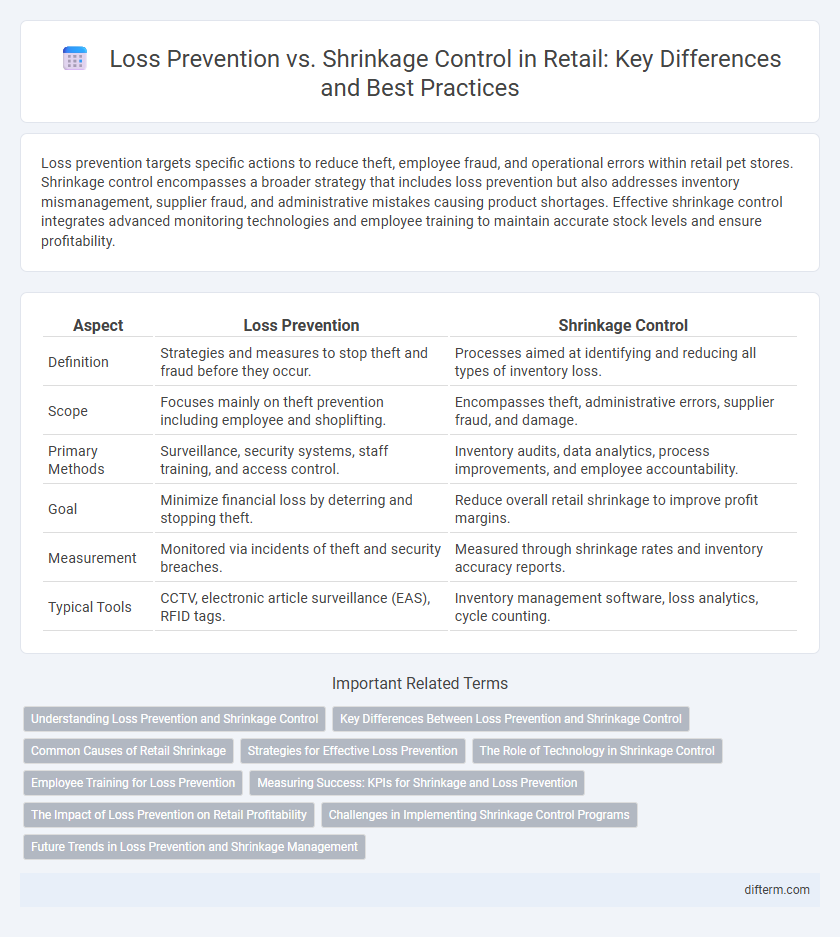Loss prevention targets specific actions to reduce theft, employee fraud, and operational errors within retail pet stores. Shrinkage control encompasses a broader strategy that includes loss prevention but also addresses inventory mismanagement, supplier fraud, and administrative mistakes causing product shortages. Effective shrinkage control integrates advanced monitoring technologies and employee training to maintain accurate stock levels and ensure profitability.
Table of Comparison
| Aspect | Loss Prevention | Shrinkage Control |
|---|---|---|
| Definition | Strategies and measures to stop theft and fraud before they occur. | Processes aimed at identifying and reducing all types of inventory loss. |
| Scope | Focuses mainly on theft prevention including employee and shoplifting. | Encompasses theft, administrative errors, supplier fraud, and damage. |
| Primary Methods | Surveillance, security systems, staff training, and access control. | Inventory audits, data analytics, process improvements, and employee accountability. |
| Goal | Minimize financial loss by deterring and stopping theft. | Reduce overall retail shrinkage to improve profit margins. |
| Measurement | Monitored via incidents of theft and security breaches. | Measured through shrinkage rates and inventory accuracy reports. |
| Typical Tools | CCTV, electronic article surveillance (EAS), RFID tags. | Inventory management software, loss analytics, cycle counting. |
Understanding Loss Prevention and Shrinkage Control
Loss prevention encompasses strategies and technologies designed to identify, deter, and mitigate theft, fraud, and errors in retail operations to safeguard assets and maintain profitability. Shrinkage control specifically targets the reduction of inventory loss caused by employee theft, shoplifting, administrative errors, and vendor fraud, often measured as a percentage of sales. Understanding the distinction between loss prevention and shrinkage control enables retailers to implement tailored interventions that effectively minimize financial losses and optimize supply chain integrity.
Key Differences Between Loss Prevention and Shrinkage Control
Loss prevention focuses on strategies and technologies designed to stop theft and fraud before they occur, including employee training, surveillance systems, and access controls. Shrinkage control addresses the broader issue of inventory loss from various sources such as theft, administrative errors, supplier fraud, and damage during handling. While loss prevention is a proactive approach targeting specific criminal activities, shrinkage control encompasses both prevention and mitigation of all types of inventory discrepancies affecting retail profitability.
Common Causes of Retail Shrinkage
Common causes of retail shrinkage include employee theft, shoplifting, administrative errors, and supplier fraud. Loss prevention strategies target these issues by implementing surveillance systems, employee training, and inventory controls to mitigate risks. Effective shrinkage control combines technological solutions with staff accountability to reduce financial losses in retail operations.
Strategies for Effective Loss Prevention
Effective loss prevention strategies in retail focus on comprehensive risk assessment, employee training, and advanced surveillance technology to deter theft and operational errors. Implementing real-time data analytics helps identify patterns leading to shrinkage, enabling proactive measures and targeted interventions. Collaboration between store management, security teams, and staff fosters a culture of accountability and vigilance, significantly reducing losses.
The Role of Technology in Shrinkage Control
Advanced technologies such as AI-powered surveillance, RFID tagging, and real-time inventory tracking play a critical role in shrinkage control by identifying and preventing theft and operational errors. Retailers leverage data analytics platforms to detect suspicious patterns and streamline audit processes, enhancing overall loss prevention strategies. Integration of IoT devices provides continuous monitoring and instant alerts, significantly reducing shrinkage rates and boosting profitability.
Employee Training for Loss Prevention
Employee training for loss prevention is critical in retail to minimize shrinkage caused by internal theft, errors, and procedural lapses. Well-structured training programs enhance staff awareness of security protocols, recognize suspicious behavior, and enforce compliance with inventory management standards. Investing in continuous education reduces overall shrinkage rates and fosters a culture of accountability among employees.
Measuring Success: KPIs for Shrinkage and Loss Prevention
Key performance indicators (KPIs) for shrinkage control include shrinkage rate, inventory accuracy, and sales variance, which directly measure inventory loss and operational inefficiencies. Loss prevention KPIs focus on metrics such as incident frequency, recovered inventory value, and employee compliance rates to evaluate the effectiveness of security protocols. Both sets of KPIs provide actionable insights for reducing financial losses and improving overall retail profitability.
The Impact of Loss Prevention on Retail Profitability
Effective loss prevention strategies directly reduce retail shrinkage, significantly enhancing profit margins by minimizing theft, administrative errors, and supplier fraud. Implementing advanced technologies such as RFID tagging and video surveillance accelerates detection and deterrence of losses, resulting in substantial cost savings and improved inventory accuracy. Retailers investing in loss prevention training and analytics report up to a 30% reduction in shrinkage, translating into higher operational efficiency and increased overall profitability.
Challenges in Implementing Shrinkage Control Programs
Implementing shrinkage control programs in retail faces challenges such as accurately identifying the sources of loss, including theft, administrative errors, and supplier fraud. Ensuring employee compliance and engagement while maintaining a positive store environment requires effective training and communication strategies. Limited resources and the need for advanced technology integration complicate continuous monitoring and timely response to loss incidents.
Future Trends in Loss Prevention and Shrinkage Management
Emerging technologies such as AI-driven video analytics and IoT sensors are transforming loss prevention by enabling real-time detection of theft and operational inefficiencies. Predictive analytics are increasingly used to anticipate shrinkage patterns, allowing retailers to implement proactive measures tailored to specific store environments. Integration of blockchain for supply chain transparency further enhances shrinkage control by ensuring product authenticity and reducing internal fraud.
Loss Prevention vs Shrinkage Control Infographic

 difterm.com
difterm.com